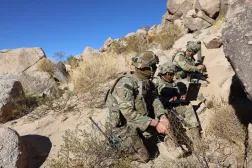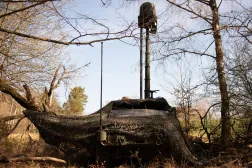As Army rebuilds electronic warfare arsenal, it looks to tailor for regions and echelons

AUGUSTA, Ga. — The Army is in the process of evaluating its electronic warfare portfolio, including capabilities and concepts, as it looks at potential conflicts in two theaters of the world.
The National Defense Strategy, published in 2022, names China as the Department of Defense’s pacing challenge with Russia as an acute threat. Those two theaters pose distinct challenges for the electronic warfare community in the target sets and the physical attributes, which can affect how signals travel.
“The Army is undertaking this pretty large assessment of the EW portfolio focused on lessons learned” in the European area of responsibility, as well as what would be needed in Indo-Pacific Command, Brig. Gen. Wayne “Ed” Barker, program executive officer for intelligence, electronic warfare and sensors, told DefenseScoop in an interview at the TechNet Augusta conference. “There gets to be a lot of focus on the distances related to the PACOM [area of responsibility] … We’ll probably be getting some guidance over the next probably 30 to 60 days on the overall EW portfolio.”
After Russia initially invaded Ukraine in 2014, one of the big lessons the Army took away from that was the importance of electronic warfare and electromagnetic spectrum operations. Ukrainian forces were geolocated based on how much they were emitting in the spectrum and then fired upon, forcing the U.S. Army to pursue a complete overall in how it built and maneuvered its command posts.
It also demonstrated that the Army needed to reinvest in its electronic warfare and electronic attack arsenal that it divested after the Cold War.
Despite that wake-up call, the Army still does not have a program of record jammer in the field and officials continue to point to the current conflict in Ukraine to show how important electronic warfare is.
“The European [theater] definitely has driven a lot of this and it’s just shined a light as an Army, as an institution, we’ve let that capacity atrophy to some degree,” Barker said.
Others noted that requirements had been written for the European theater and now there is a wake-up call for the rest of the world.
“The requirements that were written, that are going to the [program manager] that they’re prototyping now precede the [current] Ukraine conflict. How do we catch up lessons learned with something that’s already in programmatics?” Col. Gary Brock, director and Army capabilities manager for electronic warfare, told DefenseScoop at TechNet Augusta. “As we think forward, in the EW portfolio, as we look at what’s happening in Russia, the [Nagorno-Karabakh] region, those two conflicts, it’s really been a wake-up call. What is the EW threat, not only just from an ability to generate energy, but what’s targetable? And that would be us. It’s really caused an Army internal moment to take a breath. OK, how do we rethink our fight?”
The Army has been forced to look at what theater capabilities are going to be needed – and to some degree, tailoring them as opposed to one kit for the entire force – and what echelon forces need what.
“What we’re looking for when I say family of systems is: echelon-based, theater-specific,” Brock said.
For Indopacom, Brock said capabilities will need to be capable of performing at longer ranges.
For example, the Army has altered its approach to its higher echelon, long-range sensing system, the Terrestrial Layer System-Echelons Above Brigade. It was designed for higher echelons — primarily division and corps — that will need to monitor and sense the battlefield across greater distances than lower, more tactically focused echelons. It will be used by the Army’s Multi-Domain Task Force.
“We can see that effort being tailored to different AORs based on the ranges and signals of interest that they would have to go after,” Barker said. “We see coming out of the different evaluations and modeling and try to understand what can be done from the ground, at what distance, because we will have to make a decision on what that looks like. What does it look like to get to the ranges that are being asked and what does that look like from a footprint standpoint, because we got to be very conscious.”
The platform has to “flex,” Francis Orzech, chief engineer for electronic warfare and cyber at PEO IEW&S, told DefenseScoop.
“That’s got to remain at the forefront because it can go to different places, different theaters, different targets, different geographies,” he said.
The Army is now transitioning to fighting with higher echelons as it must take on the possibility of larger distances in potential conflict with greater firepower in more sophisticated adversaries than non-state insurgent groups.
“When you come back to the division and the corps, now you’re starting to nuance between an INDOPAOM fight and a EUCOM fight,” Brock said, regarding how the Army is thinking of fighting at echelon and what capabilities must exist where. “Those families of systems and requirements are going to be very unique with different physics challenges within those families of systems. A division set or a corps set in INDOPACOM does have some nuances that industry partners we would like to integrate, that would already be possibly inherent in something that’s provided for EUCOM because that land-based fight is pretty native to the Army.”
When it comes to why the Army has yet to deliver systems to the force to date, officials explained that it is much more complicated than simply delivering a technology.
“It’s a bigger tail than just materiel accelerating materiel. It is broader than the acquisition materiel side, it’s the entire [Doctrine, Organization, Training, Materiel, Leadership and Education, Personnel, Facilities and Policy]. If we’re not advancing together, we’re really kind of fits and starts and we’re kind of not meshing totally,” Orzech said. “It’s that DOTMLPF-P that could really speed things up.”
With new capabilities and concepts, the Army must get the doctrine together, force structure to operate it and train the new personnel, among other things, before introducing it to the field as an official program.
Additionally, the lack of adequate test facilities to actually turn the jammers on hampers the timeline. Turning on jammers requires coordination with other federal agencies so as to not interfere with commercial systems such as airplanes, which limits training and testing.
“There are not many test ranges that will allow you to do the things we need to test … there’s a lot of limitations with that. There’s also a requirement to be able to train that at home station, so what does that look like,” Barker said. “You have to be able to do that. What’s good enough? Is it simulation, because you’re not going to be able to take this thing out and fire it up and have the [Federal Aviation Administration] calling.”
Three tiers of Army EW capabilities
The Army is thinking of three tiers of electronic warfare capabilities: high altitude, aerial and terrestrial.
Broadly, the high altitude will be focused on navigation warfare. The aerial layer will focus on disrupting, degrading, denying or amplifying effects. And the terrestrial layer will focus on disrupting enemy decision cycles within the edge of the battle.
Despite a raft of capabilities in development that will be fielded in the coming years spanning these tiers, the concept for how they interact and are operated is “very cerebral” currently, Brock said.
“When we think about the EW portfolio, we have to live natively in the maneuver, fires and effects,” he said.
In fact, in the fall, the Army will be experimenting with how it employs electronic warfare capabilities in combat during the Maneuver and Fires Integrated Experiment, or MFIX, exercise at Fort Sill.
Electronic warfare came from the fires community and Brock explained it is still thought of as a fires capability.
“I see EW being a very integrated portion of the next generation of fires,” he said. “Our first formation, I don’t see those being able to divorce themselves or isolate themselves from the EW fighters and the capabilities.”
At MFIX, the Army is taking some electronic warfare capabilities into a live operational experiment to analyze the shortfalls and the levels of integration.
Brock also pointed to the notion of what he termed disaggregating electronic attack from the platforms. One of the problems with creating electronic attack capabilities based on platforms that soldiers will be driving is once they are turned on to perform their designed effect, they effectively become a target as well given their electronic emission.
The goal is then to take that jamming capability and push it out to smaller, attractable systems that can be lost at no risk to soldiers or missions.
Moreover, Brock explained that in order to generate the desired effect, these systems and capabilities must be airborne to deliver their signals. This is where the Army is going with what it calls launched effects.
“Gaining altitude through a tethered UAS doesn’t really get us away from the platform. It just gives us a higher signature in the physical space,” he said. “Getting into launched effects or unmanned UASs or RSVs, which the infantry school is currently developing, give us those opportunities to partner and pair the EA on multi-platforms and gives as the multi-role and we want those small, we want them attributable so that they’re just can go away.
These would be systems – such as ALTIUS-600 or Coyote – that are launched from a ground platform and on the fly.
Brock said there is an approved Army requirement for them and they are working on an updated requirement focused on the distances required in Indopacom and what payloads can accomplish that.






